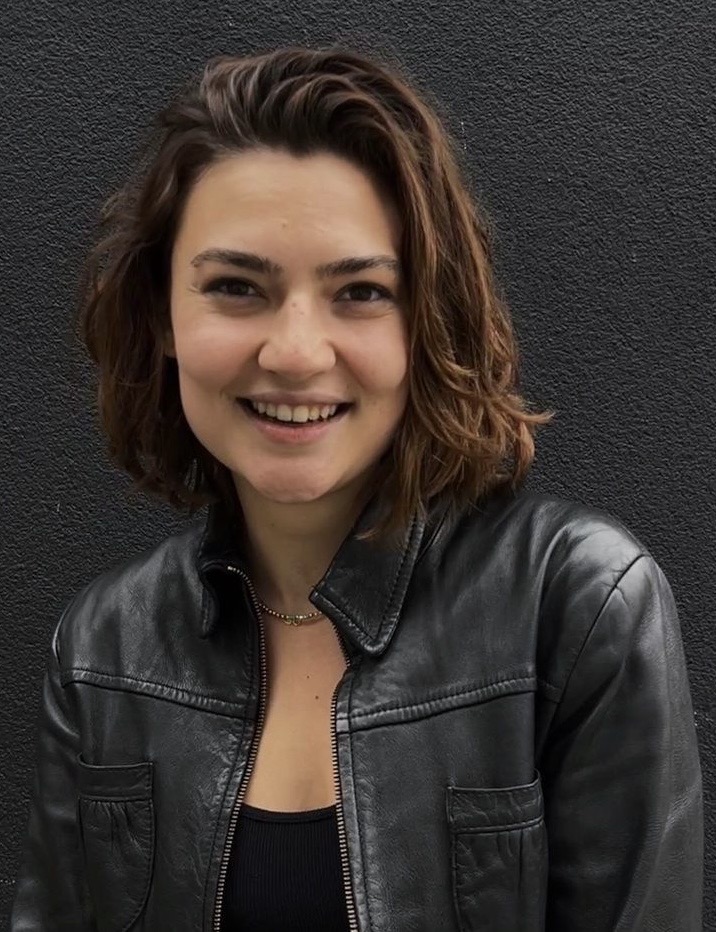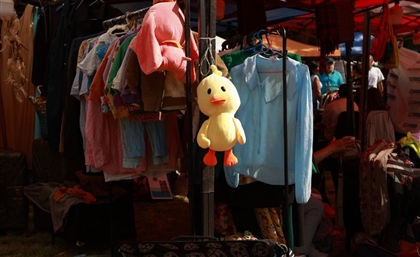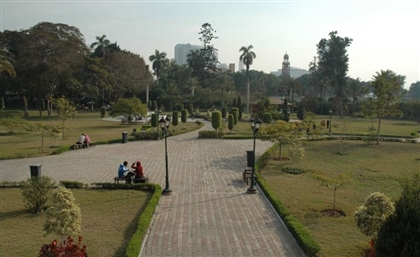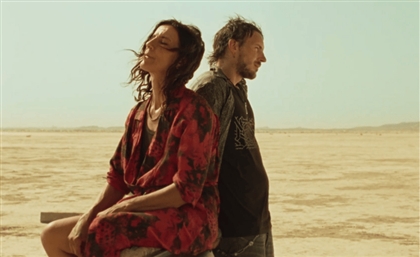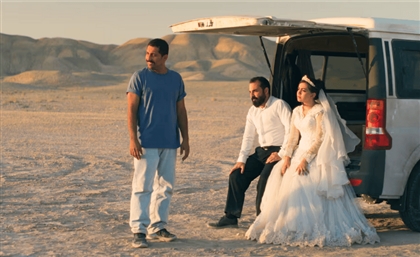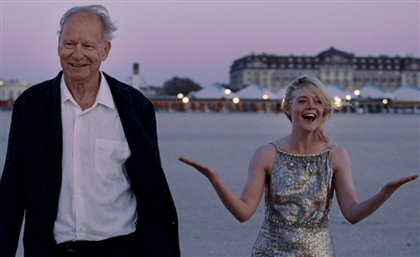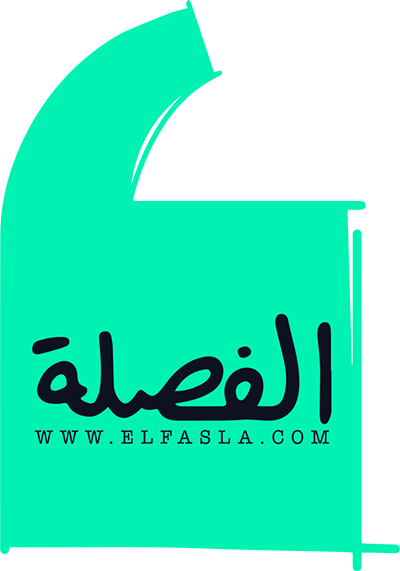A Firsthand Look at the Theater Of Rewears at Cairo’s Flea Market
A first-hand look at Cairo Flea Market, where hand-drawn denim, closet purges, & mom-and-son brands turn reuse into performance.
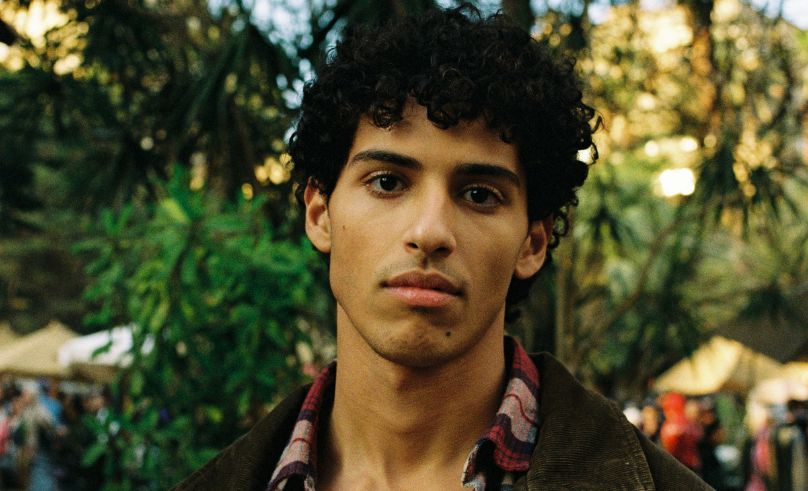
By the time I push through the gates, Cairo Flea Market is already in full performance: hangers clatter like cymbals, a seller calls out different sizes over a bassline of car horns, and a lace curtain, probably dug out from someone’s living room, billows into an improvised dressing room.
But there is a method to madness. Up front, a stream of local labels sells crafts and bespoke designs from printed tees to crochet bags. Further back, a patchwork of individual sellers display their best second-hand clothing – from friends selling their combined closet purges to housewives-turned-archivists who now show up every month with new finds. On the right, a collection of vintage shops hosts their makeshift rails, with a horde of Gen Zers shifting through Y2K denim and slinky halters.
Making my way through these mountains of clothing and stuffed suitcases of vintage accessories, I find myself at the heart of the storm: a drum circle drawing in all ages next to a home-built skate park, where kickflips and nollies cut across palm trees and the Cairo Tower.-f649fa5d-0f82-4e92-9f34-b6bbee6d7429.jpg) Amidst this sonic and visual overload, what stands out the most is the styling. Zamalek’s Al Horreya Garden becomes an ad hoc runway. In their most adorned selves, people clearly come to be seen; as Micho, a market first, puts it, the looks are “head-to-toe performative.” But maybe that’s the point? Somehow, every low-waisted jean and key chain haul is pushed to exaggeration yet still individualized. There’s play here – trying on different characters and silhouettes that most times need to be dimmed to navigate the everyday streets of Cairo.
Amidst this sonic and visual overload, what stands out the most is the styling. Zamalek’s Al Horreya Garden becomes an ad hoc runway. In their most adorned selves, people clearly come to be seen; as Micho, a market first, puts it, the looks are “head-to-toe performative.” But maybe that’s the point? Somehow, every low-waisted jean and key chain haul is pushed to exaggeration yet still individualized. There’s play here – trying on different characters and silhouettes that most times need to be dimmed to navigate the everyday streets of Cairo.
That Saturday morning, I came ready to watch a treasure hunt and instead found a theater show and a nagging itch to discover who the people of Cairo Flea Market were and what kept drawing them back in?
-64f0563b-c2eb-4279-8e42-468919391553.jpg) Meet Gasser and Naya. Gasser pairs a silver Mini Dome from Okhtein with a fistful of vintage rings scavenged from corner shops. He likes “mixing higher-end Egyptian brands and foreign staples,” and returns to the market for the one-off vintage scores, “the flea market is like a game,” one you can’t play in regular stores. But it’s also the people: “I love seeing all the different styles,” he says, using the market to find like-minded friends and other creatives. Naya – skull tank, tattoos peeking – says it reminds her of the eccentric circles she moved through in Lebanon. For her, the draw to the market is simple: a place “where you can wear whatever you want comfortably and meet really cool people.” Both Naya and Gasser come for the clothes and stay for the company.
Meet Gasser and Naya. Gasser pairs a silver Mini Dome from Okhtein with a fistful of vintage rings scavenged from corner shops. He likes “mixing higher-end Egyptian brands and foreign staples,” and returns to the market for the one-off vintage scores, “the flea market is like a game,” one you can’t play in regular stores. But it’s also the people: “I love seeing all the different styles,” he says, using the market to find like-minded friends and other creatives. Naya – skull tank, tattoos peeking – says it reminds her of the eccentric circles she moved through in Lebanon. For her, the draw to the market is simple: a place “where you can wear whatever you want comfortably and meet really cool people.” Both Naya and Gasser come for the clothes and stay for the company.
-db50265f-8e1f-4b2e-86e8-6477bd06c8ee.jpg) At the next stall, a giggle – “It’s Jean Paul Gaultier!” – as Yassine shrugs into a pleated jacket, Nelly holding up a small vanity mirror. Nelly’s one of the long-timers at the market. Coming from Denmark, where the vintage scene is huge, she arrived in Cairo a decade ago and found that there was nowhere to sell her pieces. When she first started her search, people would question why anyone would ever buy used stuff. In search of carving out a space, she started a makeshift flea market on a rooftop in Tagamoa, expanding slowly until eventually the Cairo flea market became home. “It’s grown every year,” she says, “vintage is now cool and a way to build a personal style with one-of-a-kind finds.” But for her, it’s also theater – the exchange, the read. “When I see someone truly in love with something, I might even give them a present,” she says. “I know it’ll live in their life, not just sit in a closet.”
At the next stall, a giggle – “It’s Jean Paul Gaultier!” – as Yassine shrugs into a pleated jacket, Nelly holding up a small vanity mirror. Nelly’s one of the long-timers at the market. Coming from Denmark, where the vintage scene is huge, she arrived in Cairo a decade ago and found that there was nowhere to sell her pieces. When she first started her search, people would question why anyone would ever buy used stuff. In search of carving out a space, she started a makeshift flea market on a rooftop in Tagamoa, expanding slowly until eventually the Cairo flea market became home. “It’s grown every year,” she says, “vintage is now cool and a way to build a personal style with one-of-a-kind finds.” But for her, it’s also theater – the exchange, the read. “When I see someone truly in love with something, I might even give them a present,” she says. “I know it’ll live in their life, not just sit in a closet.”
-4b5cc3d0-ad6b-4ad2-b3ef-dc71870d0bd6.jpg)
-65401599-205d-4c2b-b44d-821bec15187c.jpg) Salma is drawn to that tactile intimacy. “When I shop online, something might look nice, but then fit completely wrong,” she says, “here I get to feel the material.” Her style is hushed: a black ribbed tank skimming the shoulder, a sand-toned skirt slung low, one shell pendant catching the sun. She calls her wardrobe a capsule she can re-wear – explicitly no fast fashion.
Salma is drawn to that tactile intimacy. “When I shop online, something might look nice, but then fit completely wrong,” she says, “here I get to feel the material.” Her style is hushed: a black ribbed tank skimming the shoulder, a sand-toned skirt slung low, one shell pendant catching the sun. She calls her wardrobe a capsule she can re-wear – explicitly no fast fashion.-1c44ca2d-4095-4b92-989d-09c44c5f9f66.jpg) Around the bend, Egyptian label 69-R7r7a has an aim “to make art usable.” Four friends from art school upcycle the city’s leftovers, from discarded lighters to grandma’s coverlets (the ‘coverta’), into hand-drawn jeans and deconstructed jackets. Strewn across the table and their bodies, each piece feels less like a product and more like a page ripped from their sketchbook. Even how they speak, one starting and another finishing the sentence, mimics the rough-and-ready ease that matches the clothes.
Around the bend, Egyptian label 69-R7r7a has an aim “to make art usable.” Four friends from art school upcycle the city’s leftovers, from discarded lighters to grandma’s coverlets (the ‘coverta’), into hand-drawn jeans and deconstructed jackets. Strewn across the table and their bodies, each piece feels less like a product and more like a page ripped from their sketchbook. Even how they speak, one starting and another finishing the sentence, mimics the rough-and-ready ease that matches the clothes.
-aec27fd9-b506-4e20-82cd-a7fcd444164c.jpg)
-d7ea5422-1923-4a42-a39c-34b05f1ddc0a.jpg) Leaning into this artist-turned-fashion designer arc, Salma and her son Maragi come to sell his mom’s bespoke pieces. Taking jewelry and garments from her wardrobe, she paints her designs on top and reworks the fabric. For the last couple of years, Cairo Flea Market has become a monthly ritual for the two of them, where their artistic pursuits have an awaiting audience.
Leaning into this artist-turned-fashion designer arc, Salma and her son Maragi come to sell his mom’s bespoke pieces. Taking jewelry and garments from her wardrobe, she paints her designs on top and reworks the fabric. For the last couple of years, Cairo Flea Market has become a monthly ritual for the two of them, where their artistic pursuits have an awaiting audience.
-0bd929fe-94f7-4902-8a54-f8102e407ff6.jpg) On the other hand, friends Mariam, Heidi, and Shosha decided impromptu that they would merge their unwanted pieces and give them a new home. Their criteria was simple: “If I haven’t worn it for three years, I don’t need it.” Instead of letting things sink deeper into the closet, or worse – tossing it – they set up together and tried their luck.
On the other hand, friends Mariam, Heidi, and Shosha decided impromptu that they would merge their unwanted pieces and give them a new home. Their criteria was simple: “If I haven’t worn it for three years, I don’t need it.” Instead of letting things sink deeper into the closet, or worse – tossing it – they set up together and tried their luck.
To understand the engine behind all this, I went to the source: the market’s founder, Aya Shedid. Starting 13 years ago, the explicit aim was to "start a movement in Cairo. In the old days, Egyptians didn’t thrift. Now, however, with the new generation, Gen Zers are embracing the idea of conscious living and slow fashion.” It was essential to create a grassroots ecosystem where different people could come together and create a safe and accessible space: “We give the chance to local brands, to new businesses, to farmers… even the housewives that make jam at home.” That skatepark that looked so integral to the market… a guy messaged Aya a couple of days before and asked if he could bring a mini skate park – and she said: yes, of course.
Nonetheless, there is a vetting system: only clean, well-kept pieces make the cut; no surprise when more than 1,500 people apply for limited spots. The process is quite simple: you sign up online, the organizers look at the products – not the brand or who you are – and if it fits, you’re in. Even as the market grows throughout the years, it's the community that brings people back.
It’s clear that sustainable fashion grows louder in prevalence in the region, with higher-end labels cleaning up supply chains and sourcing smarter. But being part of this carnival of clothes and craft, the deeper change is ground-up – how people dress, what they keep, and how they discard. Cairo Flea Market reads like a micro-ecosystem of that shift: hangers clicking, tote bags heavy with second lives, a vendor holding a mirror to a stranger who smiles, turns, and chooses to wear what already exists.
- Previous Article Farah El Charkawy & Tamara Rigo Explore Dessert as Discipline
- Next Article Six Unexpected Natural Wonders to Explore in Egypt
Trending This Week
-
Dec 04, 2025







